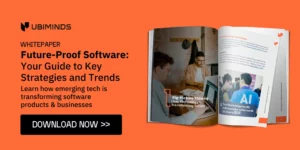Cloud computing vs. edge computing: these two pivotal technologies shape modern IT infrastructure. While cloud computing offers scalable, flexible solutions for data storage and processing, edge computing brings real-time data processing closer to the source. Explore their synergy and benefits in this comprehensive guide.
Cloud computing and edge computing are cornerstones of modern IT infrastructure, each playing distinct but crucial roles in storing and processing of databases, networking, and software.
Cloud Computing: Scalable Powerhouse

Traditional on-premise infrastructure can’t keep pace with the explosive growth experienced by many software companies. Photo by fran innocenti
Cloud computing services deliver a wide range of resources – from data storage and computation power to software as a service (SaaS) and databases – over the internet. Its core strengths lie in cost-effectiveness and flexibility:
- Scalability: Resources can be rapidly provisioned and scaled up or down as business needs evolve.
- Flexibility: Cloud services offer a pay-as-you-go model, eliminating upfront infrastructure costs. Public cloud services like Amazon Web Services and Microsoft Azure provide customizable solutions to meet diverse business needs.
- Ubiquitous Access: Users can access data and applications from anywhere with an internet connection, fostering remote work and collaboration. This accessibility is a hallmark of public and private clouds, ensuring that computer systems remain functional and connected regardless of location.
For enabling ubiquitous, convenient, on-demand network access to a shared pool of configurable computing resources (e.g., networks, servers, storage, applications, and services) Cloud Computing can be rapidly provisioned and released with minimal management effort or service provider interaction.
Where Cloud Computing Services Shine
Benefits include self-service provisioning, elasticity, mobility, workload resilience, migration flexibility, broad network access, disaster recovery and pay-per-use.
- Large-scale data processing and analytics. Data analytics platforms leverage cloud infrastructure to process data in real time, facilitating informed decision-making.
- Supporting global operations with geographically dispersed teams.
- Maintaining high availability of applications and services.
- Optimizing resource allocation and compute infrastructure utilization, freeing organizations to focus on core business activities.
The Mechanics
Cloud computing utilizes virtualization, allowing users to access resources through a web browser or dedicated applications. Data resides in remote, secure data centers managed by cloud service providers, who offer various service models:
- Infrastructure as a Service (IaaS): Offers a platform for developing, deploying, and managing applications, integrating open source technologies and operating systems.
- Platform as a Service (PaaS): Offers a platform for developing, deploying, and managing applications.
- Software as a Service (SaaS): Delivers ready-to-use software applications over the internet.
These cloud computing services ensure robust security and reliability.
Who Benefits?
Businesses of all sizes can leverage cloud computing. Startups gain cost-effective solutions, while enterprises benefit from scalable infrastructure for global reach. Cloud computing empowers developers, IT admins, and business leaders alike, driving innovation and competitive advantage.
Cloud to Edge Computing: Bridging the Gap

“Think from the customer perspective: do they know what server and tech we’re using? Maybe not. That’s not a point of interest. If it’s running smoothly and reliably and fast, that’s what matters.” – Abdullah Jubayer on CloudOps Success
The rise of edge computing marks a shift towards decentralized real-time data processing and analytics.
It delivers faster decision-making, local and offline data processing, as well as reduced data transfer to the cloud (e.g. filtered, computed, extra- or interpolated data), which saves both bandwidth and cloud storage costs.
Hybrid cloud solutions allow businesses to leverage both cloud and edge computing for optimal performance.
Power at the Periphery

Healthcare Software Teams work together with hardware, IoT and clinical experts to save lives. Photo by National Cancer Institute
Edge computing brings computation power closer to the data source, minimizing latency for faster real-time data processing. IoT integration is a prime example, where edge devices process data locally to enable real-time functionality.
Edge is ideal for applications requiring:
- Low Latency: Real-time processing of data for immediate insights and actions.
- Local Processing: Offline functionality and data privacy through on-device processing.
Where Edge Computing Thrives
- Autonomous Vehicles: Enabling real-time reaction times for safety and efficiency.
- Industrial Automation: Facilitating real-time monitoring and control of machinery.
- Smart Cities: Supporting connected infrastructure for traffic management and environmental monitoring through real-time data processing.
Why Embrace Edge Computing?
Organizations adopt edge computing to:
- Enhance Operational Efficiency: Faster data processing translates to quicker response times and optimized resource utilization.
- Reduce Bandwidth Usage: Offloading processing tasks to edge devices minimizes data transfer over networks.
- Improve Application Performance: Lower latency translates to faster response times and a smoother user experience.
At the end of the day, integrating IoT devices at the edge enhances performance by enabling real-time data processing and decision-making (crucial to ehealth and fintech, but also useful in retail).
Who Wins?
Industries heavily reliant on real-time data and analytics – like IoT, smart cities, and autonomous systems – benefit significantly from edge computing. Its ability to deliver immediate insights and responsive applications empowers businesses to enhance operational agility and customer experience.
Synergy, not Supremacy
Edge computing integrates seamlessly with cloud computing through hybrid architectures. This allows local processing of time-sensitive data at the edge, while leveraging the cloud for centralized storage, data analysis, and long-term archiving.
So, those functions that need cloud connection have adequate bandwidth, while those use cases that benefit from reduced latency and offline functionality are optimized on the edge.
Latency in Cloud vs. Edge Computing
Edge computing is used to process time-sensitive data, while cloud computing is used to process data that is not time-driven.
The Speed Factor
Latency – the time it takes for data to travel and be processed – is a critical factor in choosing between cloud and edge computing.
Edge Computing’s Advantage
- Low Latency: By processing data locally, edge computing minimizes latency, enabling real-time applications with faster response times. This is crucial for applications like autonomous vehicles or industrial automation where immediate action is essential.
Cloud Computing’s Latency Burden
- Distance Matters: Data transmission to and from remote cloud servers introduces latency, which can hinder real-time applications.
Leveraging Latency for Best Results
- Identify Latency Requirements: Clearly define the latency needs of your specific applications.
- Cloud for Non-Critical Tasks: Leverage the cloud for tasks that don’t require real-time processing, such as data analysis or long-term storage.
- Edge for Time-Sensitive Actions: Utilize edge computing for applications where immediate response times are crucial.
Data Security and Privacy in Cloud vs. Edge Computing

FinTech and IoT have at last 6 types of cyberthreats to look out for. Photo by Jonas Leupe
The question isn’t cloud vs. edge for security, it’s about understanding the threat landscape for your specific data and implementing appropriate security controls across both environments.
Both cloud and edge computing offer security features, but the optimal approach for scaling product engineering teams with data privacy in mind requires a nuanced understanding of their strengths and weaknesses.
There Will Always Be Risk
Whether your data is stored locally or on the cloud, if hackers access your credentials, the risk of a breach is equal. Additionally, edge computing expands the potential attack surface by having sensitive data stored and processed across a more extensive array of systems.
On the other hand, if compromised, the data compromised is clearly defined, making the notification and subsequent actions manageable.
Cloud Security Wins
- Centralized Control: Cloud providers offer robust security measures like encryption and access controls to safeguard data in their data centers.
- Scalability: Security features can be easily scaled alongside growing teams and data volumes.
- Regulatory Compliance: Cloud providers often comply with industry-specific data privacy regulations.
Edge Security Concerns
- Distributed Attack Surface: With data processing spread across numerous devices, securing each endpoint becomes more complex, increasing the potential attack surface for breaches.
- Limited Resources: Edge devices often have fewer resources for implementing sophisticated security protocols compared to cloud data centers.
- Potential Vendor Lock-in: Reliance on specific edge device vendors might limit security options.
3 Steps for Leveraging Cloud and Edge for Security
- Hybrid cloud solutions: Implement a hybrid architecture, storing sensitive data in the cloud while processing less critical data at the edge.
- Data Minimization: Collect and process only the data necessary for specific tasks at the edge, reducing the risk of exposure if compromised.
- Regular Security Audits: Conduct regular penetration testing and security audits on both cloud and edge environments. Both AWS and Azure offer comprehensive security features for both cloud and edge deployments.
Let’s Talk Costs
In the cloud computing model, connectivity, data migration, bandwidth, and latency features are pretty expensive. This inefficiency is remedied by edge computing, which has a significantly lower bandwidth requirement and reduced latency, enhancing cost effectiveness.
By applying edge computing, a valuable continuum from the device to the cloud is created, which can handle the massive amounts of data generated. Costly bandwidth additions are no longer required as there is no need to transfer gigabytes of data to the cloud.
It also analyses sensitive IoT data within a private network, thereby protecting sensitive data. Distributed computing models benefit from edge computing by reducing data transfer volumes and improving real-time data processing.
Enterprises now tend to prefer edge computing. This is because of its optimizable operational performance, which addresses compliance and security protocols, alongside lower costs.
Bonuses of Reduced Operational Strain
Scaling product engineering teams can be a logistical challenge. Integrating cloud computing services and edge computing can streamline infrastructure management, enhancing cost effectiveness.
Cloud and edge computing, when used strategically, can alleviate this burden in several ways:
- Simplified Infrastructure Management: Cloud computing services and edge computing eliminate the need for extensive on-premises infrastructure management. IT staff can dedicate more time to core development tasks, fostering innovation and faster product development cycles.
- Scalability and Elasticity: Both cloud and edge computing offer on-demand resource scaling. Teams can easily adjust resources (storage, compute power) as project requirements evolve. This elasticity is a hallmark of intelligent cloud computing services: it eliminates the need for upfront investment in excess hardware and streamlines resource allocation based on project needs.
- Improved Collaboration: Cloud-based tools and platforms facilitate effortless collaboration and knowledge sharing across geographically dispersed teams. This fosters a more efficient and productive development environment.
Building Your Dream Team with Ubiminds

The right strategies to hire software developers cost-effectively, combine talent pools, compensation packages, and building a strong employer brand to attract top talent who value more than just a paycheck. Photo by Brooke Cagle.
With the reduced operational strain offered by cloud and edge computing, organizations can focus their energy on building the best possible product engineering team. Here’s where Ubiminds can help:
- Expert Talent Acquisition: Ubiminds specializes in connecting top-tier software professionals with high-growth companies seeking to build world-class remote teams.
- Understanding Your Needs: We understand the intricacies of both cloud and edge computing and can advise you on building a team with the right skills and experience for your specific technology stack.
- Focus on Innovation: Let Ubiminds take care of the recruitment legwork, freeing you to dedicate your time and resources to driving product innovation and achieving your business goals.
Ubiminds can help you spare 75% of the work associated with traditional hiring processes, for DevOps, SRE, and Cloud engineers. Ultimately, allowing you to focus on what truly matters – building a remarkable product.

International Marketing Leader, specialized in tech. Proud to have built marketing and business generation structures for some of the fastest-growing SaaS companies on both sides of the Atlantic (UK, DACH, Iberia, LatAm, and NorthAm). Big fan of motherhood, world music, marketing, and backpacking. A little bit nerdy too!






